In this article, we are going to study the dicot embryo and its structure of the dicot embryo. We will also learn about the development of the dicot embryo and the comparison between monocot and dicot embryos. After reading this article, readers can tell:
What is an embryo?
Comparison between monocot and dicot embryo
Development of embryo
Embryo: An Introduction
In plants, sexual reproduction happens in the fusion of the male and female gametes to create the zygote. The zygote divides more than once to become an embryo. In the early phases of evolution, monocots and dicots are similar but diverge in the later stages. Dicot seeds contain a primitive stage called a dicot embryo. Dicot seeds have two cotyledons or embryonic leaves. They have two cotyledons, an embryo axis, and a single embryo within. In older times, dicots were the only classification for angiosperms or flowering plants. In this article, we will also discuss the monocot embryo diagram.
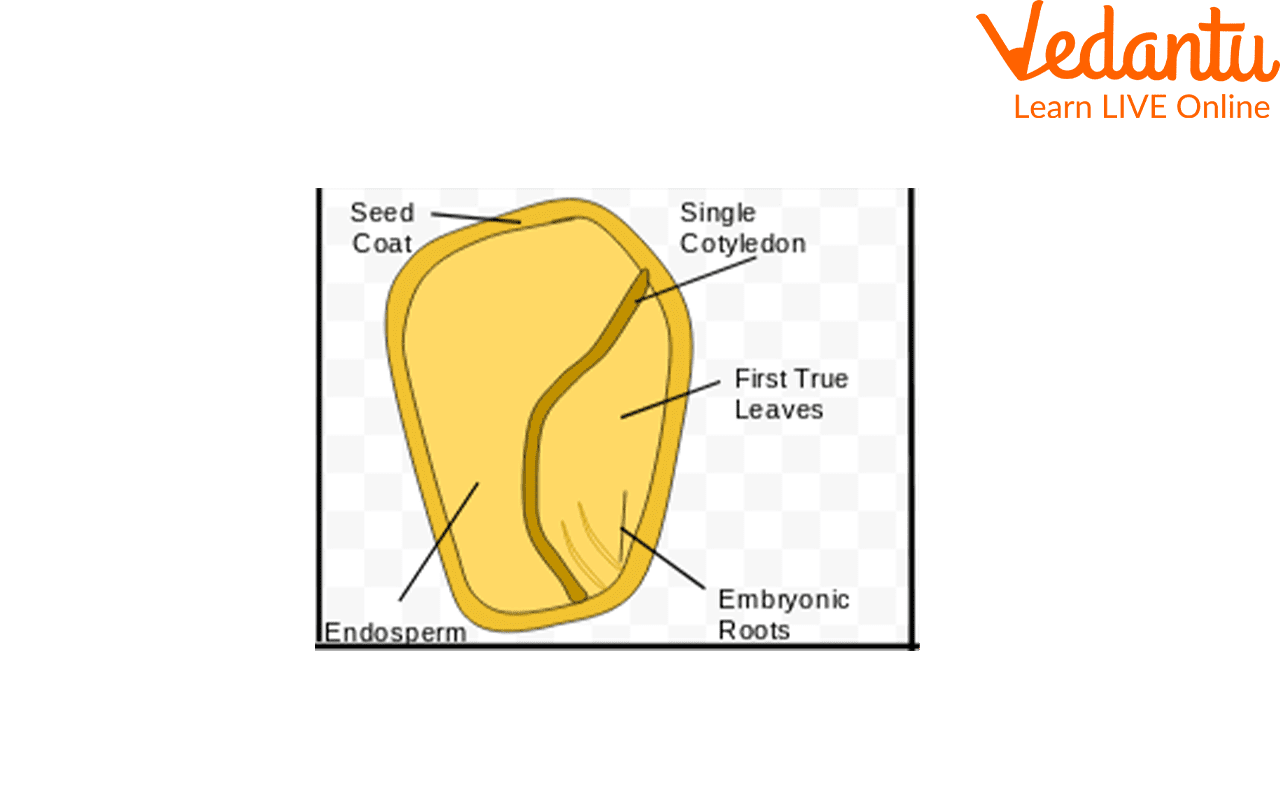
Dicot Seed
What is Embryo?
An embryo of seed is a diploid cell that develops from a zygote. The embryo is created shortly after fertilisation when the zygote divides multiple times by the patterns unique to each species. As endosperm production starts, the zygote begins to develop into an embryo. This happens because the endosperm supplies the nourishment an embryo needs to grow. Embryogenesis is the process through which a mature embryo develops from a diploid zygote.
An embryo with differentiated radicle, plumule, and cotyledons that are enclosed in the seed coat. There may be one cotyledon (monocotyledons) or two cotyledons (as in dicotyledons). They occasionally act as organs for the immature seedling's photosynthetic process or function as food reserves.
Dicot Embryo
Dicot seeds are seeds with two cotyledons or embryonic leaves. Because dicot seedlings differ in size, structure, and abundance. Most dicots have symmetrical seeds that can be divided into two halves. In dicots, the endosperm is frequently diminished and even totally absent sometimes. Dicot embryo diagram is given below.
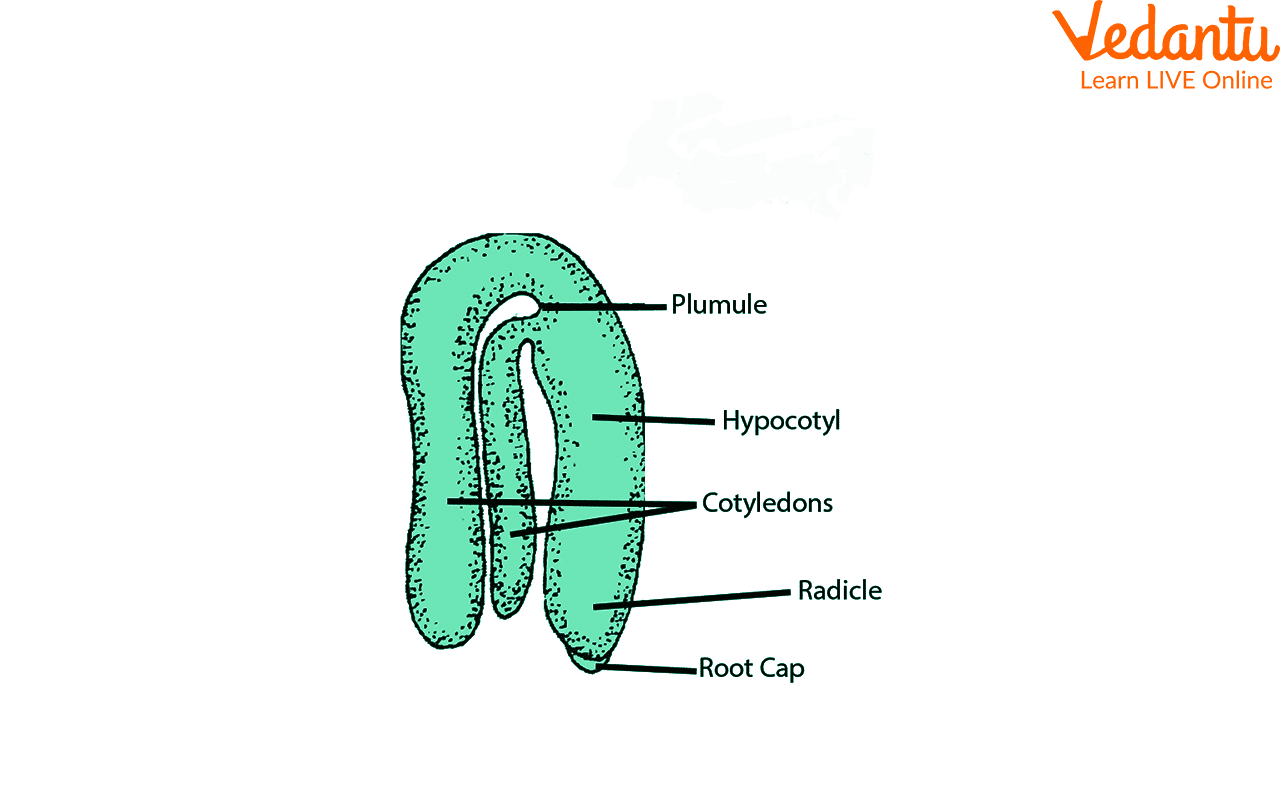
Dicot Embryo Diagram
Different species can be identified from one another using differences in seed form. Dicot seeds can also be identified by their lack of additional sheaths covering the embryo. Dicots do not share a common ancestor, hence they are not a monophyletic group.
Structure of Dicot Embryo
The word "dicotyledons" refers to the dicot seed's two embryonic cotyledons. An embryo axis and two cotyledons make up the embryo of a dicot seed.
Cotyledons have an inflated appearance because they function as a nutritional source for growing seedlings.
The plumule is located at the top end of the embryo axis and creates the shooting point. The area lying under the cotyledon level is known as the hypocotyl. The growth of the embryo into the radicle, which will eventually become the root, marks the end of the hypocotyl.
The calyptra, a root cap, protects the root tip known as the radicle. The material is completely encased in the seed coat, which serves as protection. The seed coat is made up of two layers: testa and tegmen.
The seed and fruit are additionally connected by a structure called the hilum.
Dicots include most woody plants, such as oaks, roses, peas, and tomatoes.
The structure of the dicot seed is given below. Take a look at this to understand better about dicot seed and dicot embryo.
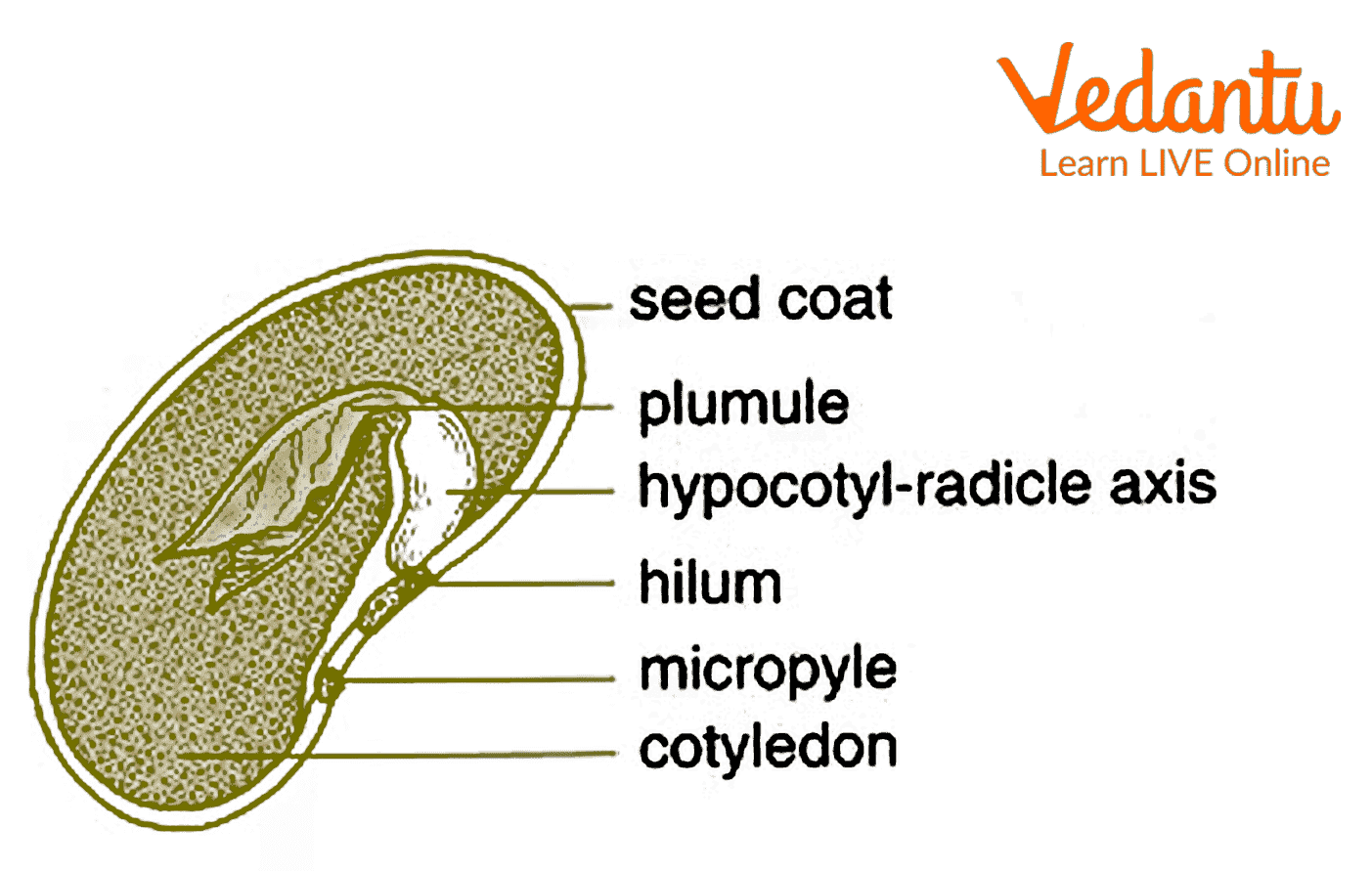
Seed
Development of Dicot Embryo
The zygote divides into two parts - the apical cell and the basal cell. The apical cell divides continuously to form an embryo, whereas basal cells divide horizontally to form 6-9 cell filaments called suspensor cells. Different stages are explained below:
Globular stage - the apical cell divides and develops into a ring layer of stems and roots.
Heart stage - cells divide rapidly on each side of the embryo. The centre cell will form an outgrowth which will convert into shoot apical meristem and cotyledon. And the middle region forms root meristems and hypocotyl.
Torpedo stage - occurs due to cell elongation, and cotyledon will convert into shoot apical meristem.
Maturation stage - in this stage seed loses water and enters the dormant stage.
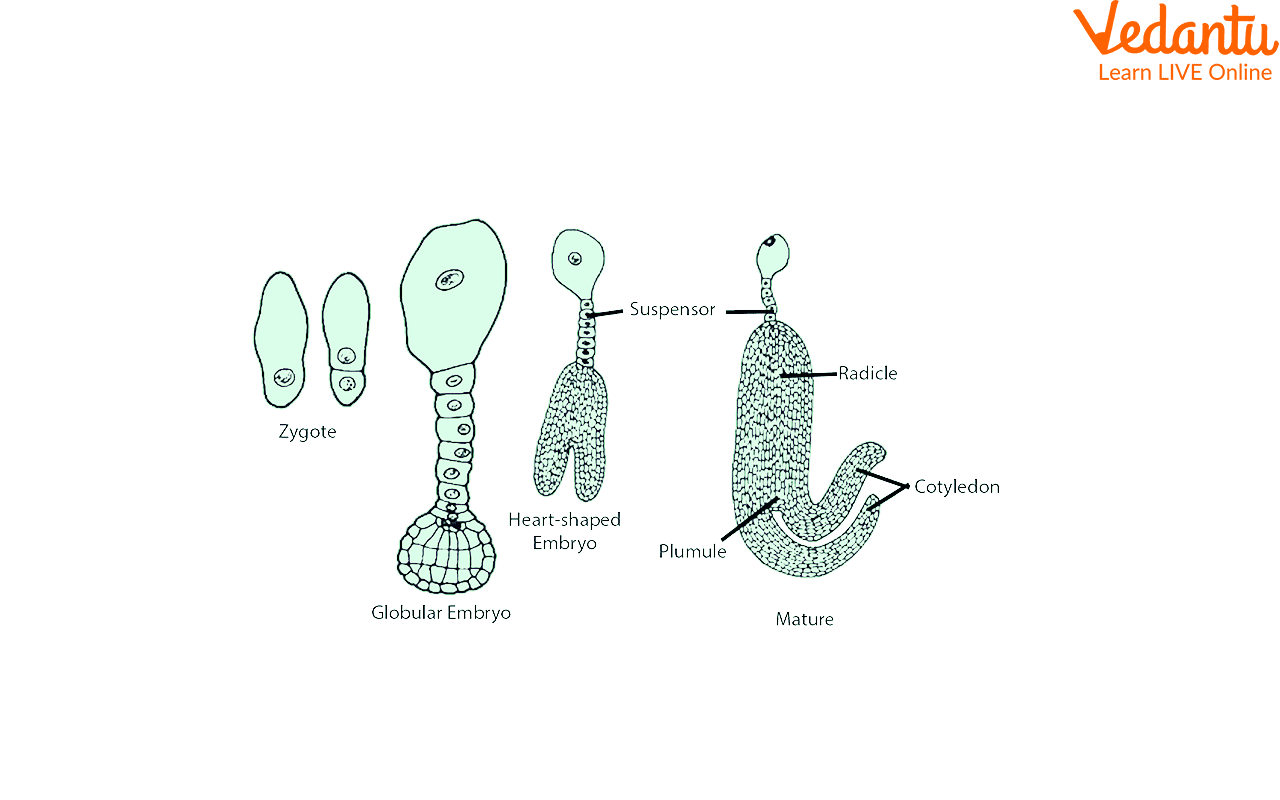
Stages of Dicot Embryo Development
Comparisons Between Monocot and Dicot Embryo
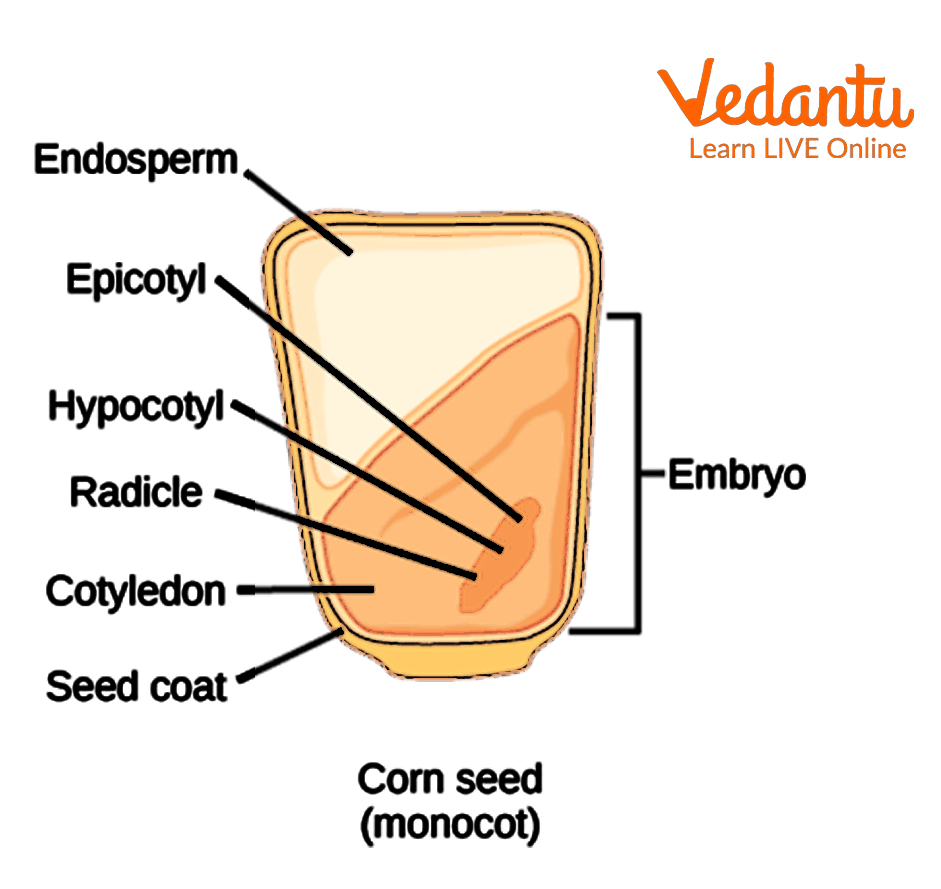
Monocot Embryo Diagram
Important Questions
1. What is the process of formation of an embryo from a zygote called?
Embryogenesis is the process of the formation of an embryo from a zygote; this process occurs after the fusion of male and female gamete, a process known as fertilisation.
2. What is the part of the embryonic axis above the cotyledons?
Epicotyl is the part of the embryonic axis present above the cotyledon; later, epicotyl will develop into the leaves of the plants.
3. What is the first cell of the suspensor functions in dicots called?
the first cell of the suspensor divides transversely to form a suspensor of 6-10 cells. Now, the first cell of the suspensor functions as a haustorium.
4. A dicot embryo divides by?
Initially, cells of the dicot divide to form basal and apical cells, and the apical cells divide and later convert into embryos, whereas basal cells, after division, convert into suspensor cells.
Interesting Facts
Strawberry is the only fruit that bears seeds outside the fruit.
You might be surprised that the Bamboo plant is the fastest-growing plant in the world.
91% of cabbage is water.
Double coconut is the largest seed in the world.
Onion soothes burn and also fights against infections due to the presence of a mild antibiotic.
Key Features
In this article, we have discussed the embryo, the dicot embryo, the structure of a dicot embryo, and the development of an embryo. Dicot seeds contain a primitive phase called a dicot embryo. They have two cotyledons, an embryo axis, and a single embryo within. Dicotyledonous or dicot seeds are found in plants like peas, almonds, and cashews.
We have also learned the differences between the structure of a dicot embryo and a monocot embryo and the different parts of a seed. Different seed parts are seed coat, embryo, and endosperm.


FAQs on Dicot Embryo
1. What is the journey of a dicot embryo?
At the micropylar end of dicots, the zygote transforms into an embryo. The zygote develops into the proembryo, then the spheroid stage, which eventually gives rise to a cordate- or heart-shaped embryo. An embryonal axis and two cotyledons make up a dicot embryo. Epicotyl is the portion of the embryonal axis above the cotyledon dimension. It has a plumule inside. The root tip is located in the parcel known as the hypocotyl, which is located beneath the centre point. The root top holds the root tip in place.
2. Explain the development of dicot embryos in angiosperms.
After an ovule has been developed, a process known as plant embryogenesis takes place to form a fully-grown plant embryo. The zygote created during reproduction must go through several cellular stages and differentiation to develop into a mature embryo. The embryo may be a monocot or dicot. The cotyledons, root meristem, root tip, shoot apex meristem, and hypocotyl are the five main parts of a final embryo. The different parts of the embryo grow to become an independent individual plant body.
3. What is the function of the embryo?
As we all know, after fertilisation of male and female gamete, there is the formation of a zygote, and the zygote converts into an embryo by the process of embryogenesis. The embryo will convert into a seedling on getting the perfect condition. Hence, the important function of the embryo is to mature into a seedling after germination. Embryo acts as a sort of starter kit for the plants.
In this article, we are going to study the dicot embryo and its structure of the dicot embryo. We will also learn about the development of the dicot embryo and the comparison between monocot and dicot embryos. After reading this article, readers can tell:
What is an embryo?
Comparison between monocot and dicot embryo
Development of embryo










